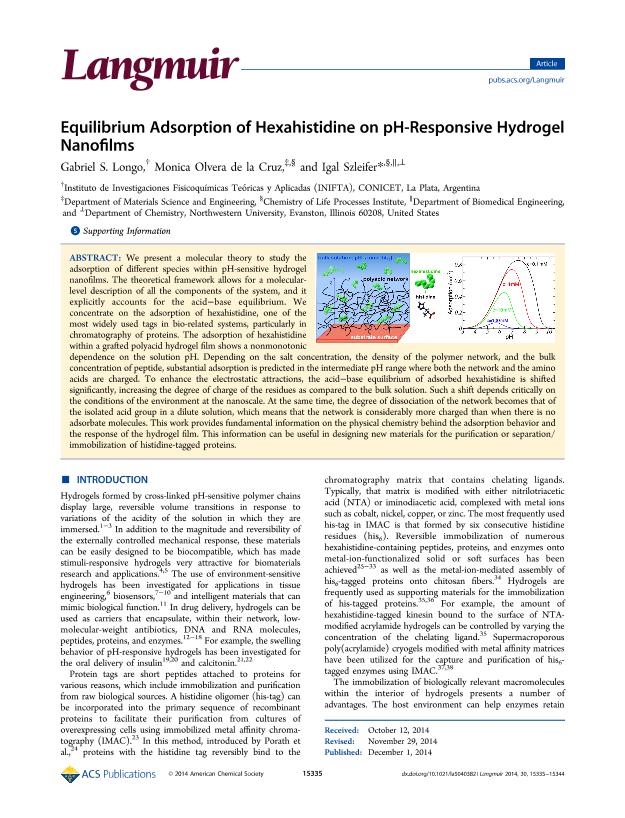Mostrar el registro sencillo del ítem
dc.contributor.author
Longo, Gabriel Sebastian

dc.contributor.author
Olvera de la Cruz, Monica
dc.contributor.author
Szleifer, Igal
dc.date.available
2016-04-11T20:31:47Z
dc.date.issued
2014-12
dc.identifier.citation
Longo, Gabriel Sebastian; Olvera de la Cruz, Monica; Szleifer, Igal; Equilibrium Adsorption of Hexahistidine on pH-Responsive Hydrogel Nanofilms; American Chemical Society; Langmuir; 30; 50; 12-2014; 15335-15344
dc.identifier.issn
0743-7463
dc.identifier.uri
http://hdl.handle.net/11336/5131
dc.description.abstract
We present a molecular theory to study the adsorption of different species within pH-sensitive hydrogel nanofilms. The theoretical framework allows for a molecular-level description of all the components of the system, and it explicitly accounts for the acid-base equilibrium. We concentrate in the adsorption of hexahistidine, one of the most widely used tags in bio-related systems, particularly in chromatography of proteins. The adsorption of hexahistidine within a grafted polyacid hydrogel film shows a non-monotonic dependence on the solution pH. Depending on the salt concentration, the density of the polymer network, and the bulk concentration of peptide, substantial adsorption is predicted in the intermediate pH range where both the network and the amino acids are charged. To enhance the electrostatic attractions, the acid-base equilibrium of adsorbed hexahistidine is shifted significantly increasing the degree of charge of the residues, as compared to the bulk solution. Such shift depends critically on the conditions of the environment at the nanoscale. At the same time, the degree of dissociation of the network becomes that of the isolated acid-group in a dilute solution, which means that the network is considerably more charged than when there is no adsorbate molecules. This work provides fundamental information on the physical chemistry behind the adsorption behavior and the response of the hydrogel film. This information can be useful in designing new materials for the purification or separation/immobilization of histidine-tagged proteins.
dc.format
application/pdf
dc.language.iso
eng
dc.publisher
American Chemical Society

dc.rights
info:eu-repo/semantics/openAccess
dc.rights.uri
https://creativecommons.org/licenses/by-nc-sa/2.5/ar/
dc.subject
Ph-Responsive Hydrogels
dc.subject
His-Tag
dc.subject
Adsorption Thermodynamics
dc.subject
Immobilized Metal Ion Affinity Chromatography
dc.subject
Molecular Modeling
dc.subject.classification
Físico-Química, Ciencia de los Polímeros, Electroquímica

dc.subject.classification
Ciencias Químicas

dc.subject.classification
CIENCIAS NATURALES Y EXACTAS

dc.title
Equilibrium Adsorption of Hexahistidine on pH-Responsive Hydrogel Nanofilms
dc.type
info:eu-repo/semantics/article
dc.type
info:ar-repo/semantics/artículo
dc.type
info:eu-repo/semantics/publishedVersion
dc.date.updated
2016-05-06 15:52:43.262787-03
dc.journal.volume
30
dc.journal.number
50
dc.journal.pagination
15335-15344
dc.journal.pais
Estados Unidos

dc.journal.ciudad
Washington
dc.description.fil
Fil: Longo, Gabriel Sebastian. Consejo Nacional de Investigaciones Científicas y Técnicas. Centro Científico Tecnológico la Plata. Instituto de Investigaciones Fisicoquímicas Teóricas y Aplicadas; Argentina. Universidad Nacional de La Plata; Argentina
dc.description.fil
Fil: Olvera de la Cruz, Monica. Northwestern University; Estados Unidos
dc.description.fil
Fil: Szleifer, Igal. Northwestern University; Estados Unidos
dc.journal.title
Langmuir

dc.relation.alternativeid
info:eu-repo/semantics/altIdentifier/url/http://pubs.acs.org/doi/abs/10.1021/la5040382
dc.relation.alternativeid
info:eu-repo/semantics/altIdentifier/doi/http://dx.doi.org/10.1021/la5040382
dc.relation.alternativeid
info:eu-repo/semantics/altIdentifier/doi/10.1021/la5040382
Archivos asociados
